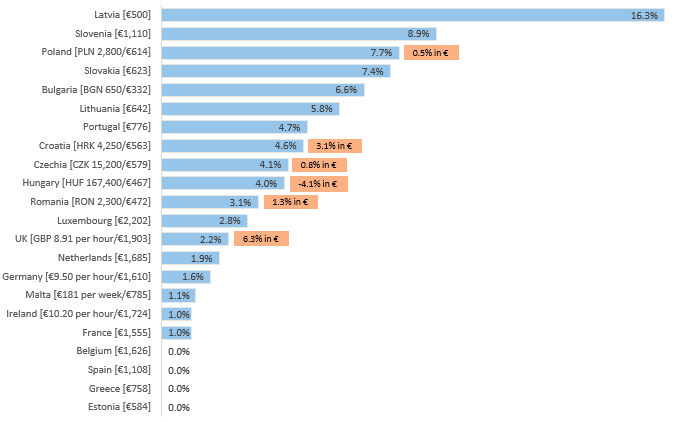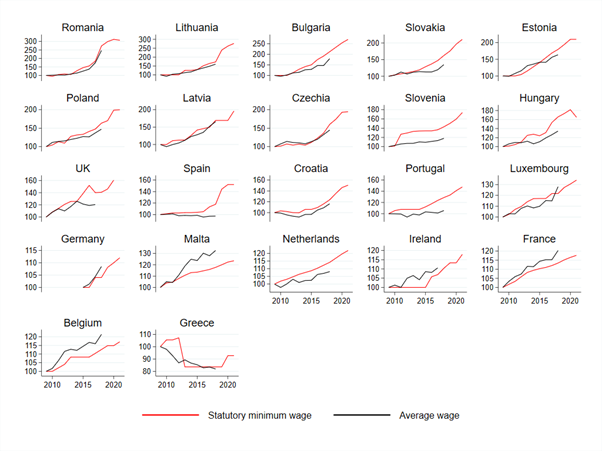Minimum wages rise again, but the pandemic puts a brake on their growth
Decision-makers approached minimum wage setting for 2021 cautiously due to the economic uncertainty caused by the pandemic. Despite this, nominal statutory minimum wages rose in most Member States and the UK, although at lower rates than in recent years.
The dilemmas for decision-makers setting the 2021 minimum wage rates were aggravated by the COVID-19 pandemic. Their usual concern to strike a balance between adequate wages for the lowest-paid employees and safeguarding jobs and businesses was amplified by the challenging economic outlook: growing unemployment, a downward pressure on wages and huge uncertainty about the future. The disruption to the normal negotiation and consultation processes, caused by the virus-containment measures, added to challenges.
Were statutory minimum wage adjustments affected by the troubled economic situation? To some extent, yes: while rates rose in 2021 across most countries, the magnitude of the rises were lower than a year ago.
Figure 1 presents data on gross statutory minimum wages in 2021 and their growth rates (calculated in national currencies) between January 2020 and January 2021. Among these 21 EU countries with statutory minimum wage systems (plus the UK), rates rose in all but four. We can divide countries into three groups.
Countries with the largest increases (above 5%): A group of six central and eastern European countries: Latvia, Slovenia, Poland, Slovakia, Bulgaria and Lithuania. If rates were calculated in euro, however, Poland would be in the next group.
Countries where minimum wage rates rose by 1–5%: Mainly older Member States of the EU (Portugal, Luxembourg, the Netherlands, Germany, France and Ireland) and as well some Member States that joined in 2004 or later (Croatia, Romania, Malta, Czechia and Hungary). Although Hungary’s minimum wage grew by 4% in its national currency, it fell in euro terms, in which case it would be the only country to register a decline in its minimum wage. The UK is in this group, too, although the exchange rate appreciation of the British pound would place it in the first group if rates were calculated in euro.
Countries where minimum wages were frozen: Belgium, Spain, Greece and Estonia.
Despite these generally positive developments, minimum wage rises for 2021 were more modest than for 2020. The median minimum wage increase in 2021 is 3% (in national currencies), while last year it was 8.4% and all countries but Latvia recorded minimum wage increases. [1] Furthermore, the differences in minimum wage rates across EU countries reduced only modestly in 2021. These two developments are important because it means the pandemic has slowed down the ongoing process of strong minimum wage growth and minimum wage convergence across EU countries.
Figure 1: Statutory minimum wages in 2021 – Levels and growth rates

Notes: The percentages in the blue bars refer to the increases in gross statutory minimum wages in national currencies between 2020 and 2021. The percentages in the orange labels show the growth rates in euro for non-euro-zone countries. The minimum wage levels in 2021 are reported beside the country labels (monthly rates, if not otherwise indicated, and converted to reflect 12 payments in Greece, Portugal, Slovenia and Spain). Austria, Cyprus, Denmark, Finland, Italy and Sweden are not included as they do not have a statutory minimum wage.
Source: Network of Eurofound Correspondents
Strong minimum wage growth over the last decade in most countries
How have minimum wages evolved in recent years? Figure 2 depicts this evolution and that of average wages from 2009 to the most recent year that data are available (2021 for minimum wages and 2018 for average wages). The data are indexed (2009 = 100), and countries are ranked by the magnitude of their minimum wage growth over the whole period: from Romania, where minimum wages tripled, to Greece, the only country where minimum wages declined. Two main insights emerge.
Although progress in both indicators tends to go hand in hand, statutory minimum wages have increased faster than average wages in more than two-thirds of countries, which means the lowest-paid employees have experienced higher wage growth than the average employee. Among these countries, the central and eastern European Member States stand out for the exceptional growth in their minimum wages: Romania, Bulgaria, the three Baltic countries, Hungary, Poland, Slovakia and Czechia. In other countries, where increases were smaller, minimum wage growth is still very much above that observed in average wages; these include Spain (especially after the 2019 increase), [2] Portugal, the UK and Slovenia. Greece is the only country where the minimum wage level fell, although average wages declined even further.
At the other extreme, there is a small group of six countries where rises in the statutory minimum wage have not kept up with the growth in average wages. These countries are Belgium, Germany, France, Ireland, Luxembourg and Malta.
Figure 2: Evolution of statutory minimum wages (2009–2021) and average wages (2009–2018), 21 Member States and the UK

Notes: Data on monthly statutory minimum wages and average wages are presented as indexes (2009 = 100), except for Germany, where the base year is 2015, when the minimum wages were introduced. Countries are ranked by the magnitude of the average yearly growth rate in minimum wages over 2009–2021 (2015–2021 for Germany).
Source: EU-SILC data for average wages (available up to 2018); Eurostat data for statutory minimum wages
Member States with the lowest rates are catching up
EU Member States have strongly converged in their statutory minimum wage rates (as well their average wage rates) over the last decade. This is the result of two simultaneous developments in minimum wages. On the one hand, growth has been modest among the older Member States that have the highest minimum wages: Belgium, France, Germany, Ireland, Luxembourg and the Netherlands. On the other hand, there has been remarkable progress among countries that have the lowest rates, which have at least doubled those rates over the period: Romania, Bulgaria, the Baltic states, Hungary, Slovakia, Poland, Czechia and, behind them, Slovenia and Croatia. This convergence is evident when data on nominal minimum wage rates is used, but it is even stronger when correcting for differentials in economic conditions and price levels across countries.
Unlike the central and eastern European countries, the Mediterranean Member States have failed to significantly catch up with those countries that have the highest minimum wage rates. Greece is a particularly dramatic case in point: its minimum wage was cut in 2012 and subsequently frozen until 2019. More recent developments in Spain, however, are positive, especially the large increase in 2019.
Forthcoming publication: Minimum wages in 2021: Annual review
Image © Iryna/Adobe Stock Photos
Reference
^ Eurofound (2020), Minimum wages in 2020: Annual review, Publications Office of the European Union, Luxembourg.
^ Vacas-Soriano, C. (2019), The new Spanish minimum wage, Social Europe Journal.
Authors
Carlos Vacas‑Soriano
Senior research managerCarlos Vacas Soriano is a senior research manager in the Employment unit at Eurofound. He works on topics related to wage and income inequalities, minimum wages, low pay, job quality, temporary employment and segmentation, and job quality. Prior to joining Eurofound in 2010, he worked as a macroeconomic analyst for the European Commission and as a researcher in European labour markets at the Spanish Central Bank. He holds an MA in European Economic Studies from the College of Europe in Bruges and a PhD in Labour Economics from the University of Salamanca (Doctor Europaeus).
Christine Aumayr-Pintar
Senior research managerChristine Aumayr-Pintar is a senior research manager in the Working Life unit at Eurofound. She coordinates Eurofound’s research on social dialogue and industrial relations and oversees the Network of Eurofound Correspondents (NEC). Her primary research expertise – approached from a comparative EU-wide standpoint – centres on minimum wages, collectively negotiated pay and gender pay transparency. Prior to joining Eurofound in 2009 she was a labour markets and regional economics researcher at Joanneum Research in Austria. She earned a Master's degree in Economics and a PhD in Social Science/Economics having studied economics in Graz, Vienna and Jönköping.
Related content
10 June 2021
This report summarises how minimum wage rates for 2021 were set during 2020 – the year marked by the COVID-19 pandemic. It reviews the difficulties faced by national decision-makers and how they reacted to the challenges of the economic and social fall-out of the pandemic when making decisions regarding the minimum wage. It maps the extent to which minimum wages were referred to in COVID-19-related support measures. It discusses advances made on the EU initiative on adequate minimum wages and maps the reactions of the EU-level social partners and national decision-makers. The report is accompanied by two complementary working papers: one providing an analysis of developments for low-paid employees and minimum wage workers over the past decade; the other summarising the most recent research on minimum wages in EU countries, Norway and the UK.